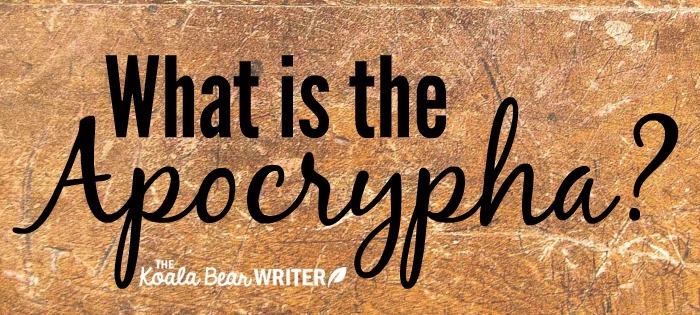When I signed up for the Common English Bible blog tour, I was asked if I wanted the version with the Apocrypha or without. I thought, “I don’t know—what is the Apocrypha?” Googling it left me with more questions than I’d had before, so I did some old-fashioned research: I dug out my first-year religious studies textbook. Then I read a few other books in our library about the Apocrypha, also known as the deuterocanonical books.
The Jewish Scriptures
What I learned is that the Old Testament or Hebrew Bible was a collection of books used well before the time of Jesus. Jews throughout the ancient world were familiar with the Law and the Prophets, and Jesus himself often referred to them:
Jesus said to them, “These are my words that I spoke to you while I was still with you—that everything written about me in the Law of Moses, the Prophets, and the Psalms must be fulfilled.” (Luke 24:44 CEB)
About two or three hundred years before Jesus’ birth, an Egyptian version of the Jewish Scriptures appeared for the library at Alexandria. Commonly known as the Septuagint (based on a story that seventy-two Jewish elders worked separately for seventy-two days to translate seventy-two identical copies), this version included some Greek writings and Greek translations of Hebrew writings that weren’t part of the original Hebrew text. As Greek became the common language of the day, this translation became the one that everyone used—including Jesus and the writers of the New Testament who quoted the Old Testament.
Margaret Finley notes, “If we had never heard of Shakespeare, we would not recognize his words when they were used by others but would think they had originated with the speaker who was quoting them. The same is true of the writings of the deuterocanonicals: Many people have never seen these books and thus do not realize that some of the words of Christ and Paul are either quotes from or illusions to the deuterocanonical books. It is obvious that Christ and Paul were familiar with these books” (Catholic Answers).
The Christian Bible
During two church councils just before 400 A.D., the Septuagint was officially accepted as the Old Testament. The books of the New Testament were also chosen around this time, based on the decisions of various popes and bishops who noted the importance of these books within their congregations. For the next thousand years, these 73 books were the Bible used by the universal church. All of those books are quoted by the Early Church Fathers as inspired Scripture.
During the Protestant Reformation, scholars developed a new interest in the ancient languages. Martin Luther proposed a return to the Hebrew canon, rejecting seven of the books in the Old Testament (he also didn’t like James and Revelation in the New Testament). However, recent research at Qumran has found Hebrew copies of some of these disputed books.
The word “apocrypha” is a Greek term meaning “hidden” or “not genuine.” It refers to the disputed nature of the these books, which are not recognized by Jews or Protestants as inspired by God. These are also known as deuterocanonical writings or “second canon” writings. Some Protestant Bibles, such as the CEB, still include these books, but put them in a section by themselves.
The Common English Bible
Thus in my copy of the Common English Bible, the Apocrypha is sandwiched between the Old and New Testaments. Listed in the table of contents are “Books included in Roman Catholic, Greek, and Slavonic Bible:” Tobit, Judith, Esther (an additional part), Wisdom of Solomon, Sirach, Baruch, Letter of Jeremiah, Prayer of Azariah (and Hymn of the Three Young Men), Susanna, Bel and the Snake, 1 Maccabees and 2 Maccabees. There are also “Books included in Greek and Slavonic Bibles” (1 Esdras, Prayer of Manasseh, Psalm 151, and 3 Maccabees) as well as “Books included in Appendix to Greek Bible” (2 Esdras and 4 Maccabees).


7 Comments
Dan – my husband and I also though that the books used by the Catholic Church are called Deuterocanonical, while the rest of the list are called the Apocrypha, but none of the sources I looked at (either in our books or online) made that distinction. Thanks for dropping by.
My ministry is in a Pentecostal denomination, but I have come to learn from the Apocrypha. They would more properly be called Deuterocanonical books… but who can say THAT mouthful all the time? 😉
Great post.
Anonymous – glad you found my post. I wrote this as much for myself as for anyone else, because it was a question that I wanted answers to. Writing about things helps me sort them out. 😉
Fi – you can check out my first post (http://thekoalabearwriter.blogspot.com/2006/08/introducing-koala-bear.html) to see the whole Koala Bear story. I have been to Australia and would love to return some day (see http://thekoalabearwriter.blogspot.com/search/label/Australia) but I’m a Canadian blogger. 🙂
Joanna – interesting! Now I’ll be watching for references to Satan in my Apocryphal reading. 🙂
Love your blog, in fact arrived by checking yahoo and google for a comparable issue to this post. Which means this might be a late post nevertheless keep up the great work.
When I was a teenager, I questioned whether Satan really was ever an angel like the whole world believes, because there was no specific mention of the actual story in my Bible, just a vague reference in Isaiah. My pastor at the time told me it was in the apocrypha, so I’ve always wanted to read it. It’s interesting to hear the history, thanks!
So just by dropping by I’ve learnt a new word – I hadn’t heard of the word ‘apocrypha’
Thank you for your comments on my post, it seems you and I have a bit in common, I also have a Bachelor degree in Arts majoring in English and a certificate in Editing and Proofreading.
You have a koala bear, is there an Australian link there somewhere?